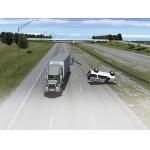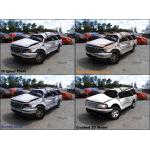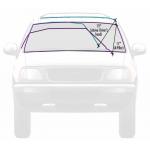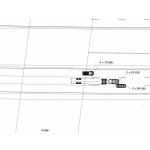Reconstructing Accidents
In accident cases, reverse-engineered animations can act as formidable legal evidence.
Latest News
January 1, 2007
By Brett Duesing
David Golomb, a Manhattan attorney who has served as president of the New York State Trial Lawyers Association, considers computer animation “devastating evidence.”
“If you have a good animation,” says Golomb, “it’s such a difficult thing for the other side to fight.” A visual account of the incident need not be played to the jury to have an effect in litigation; many times it precipitates a settlement before a trial begins. In the six cases in which Golomb has used computer animation, opposing counsel settled almost immediately.
Legal animations — a combination of artistic effects and careful scientific investigation — originate from accident reconstruction firms like Knott Laboratory, which has performed more than 10,000 accident analyses in its 24-year history. Over the last decade, its animation department has translated the mathematic conclusions of engineers into the visual language of CGI.
> > A still clip from a Knott Laboratory animation demonstrates the scientifically measured facts. After a green sedan and tractor-trailer collide, but only slightly, a secondary collision causes the white Ford Expedition to roll.
The company’s website shows short clips of past cases (click here to go to Knott Laboratory’s animations). In this mini-cinema of disaster, the main characters are machines; for example, a BMW careens into a tunnel wall and a top-down convertible speeds obliviously into the path of a locomotive. The fatal errors of these mechanical characters are often a matter of inches, and the destructive consequences occur within the span of a few seconds.
Debate over exactly what happened during this small window of time, however, can sprawl into many years of litigation. The Knott Laboratory animations give attorneys the power to define the basic facts without ambiguity. What may be only a flash in the memory of an eyewitness can be shown in slow motion and from any angle. Knott Laboratory can accurately portray the incident even if no one at the actual event saw it happen.
“If they placed video cameras at every intersection around the globe, and videotaped every accident, they wouldn’t need us,” says David Danaher, P.E., Director of Mechanical Engineering at Knott. “Unfortunately, we don’t enjoy that luxury.”
So, what makes these short clips non-fiction? The answers lies with animation tools, such as 3DS Max from Autodesk and PhotoModeler 3D photogrammetry software from Eos Systems.
Forensic engineers can reconstruct and render past events with just a few photographs of the aftermath of an accident and with small traces of evidence. For example, PhotoModeler requires only three photographs of an object from different vantage points for enough geometric data to construct a 3D model, including accurate dimensions down to the sub-inch of everything within a photographic scene.
< < Figure 1: The orange 3D splines from PhotoModeler compared to the blue-lined direct survey. Photogrammetry is now well recognized in court as a reliable and legitimate scientific method of measurement.
To virtually choreograph an auto accident, Danaher and his engineering team work backward, analyzing the final rest positions of vehicles, debris, tire marks, and most importantly, the extent of vehicle damage. The metal folds in the auto body, referred to as the crush, hold the key to many of the dynamics of an accident, including the speeds, locations, and angles of impact.
Much of the primary evidence, including the crush, can only be found in the accident-scene photographs taken by police or insurance agents. If a crushed vehicle can be located and recovered, investigators can take measurements directly. Scrap metal, however, often moves faster than the wheels of litigation. Half of the time, Danaher says, the vehicle is “long gone” by the time Knott Laboratory takes on the investigation.
“We need to know how much damage is done and we need a valid, scientifically proven method to quantify the damage to the vehicle without physically seeing it,” explains Danaher. “We’re really limited in what we have for evidence. If we have three or more photographs of a car, often it’s cheaper to use PhotoModeler rather than sending a team to find the car and survey it.”
PhotoModeler automates the science of photogrammetry, which over the last decade has gained acceptance legally as an evidentiary tool. “In our cases, we undergo Daubert challenges, which are very strict federal gate-keeping procedures for expert testimony,” reports Director of Animation Hailey Day, “PhotoModeler has consistently held up.”
On a stretch of I-95 in Florida, a semi tractor-trailer struck a Ford Expedition, causing the SUV to roll over several times, killing the SUV’s driver.
When litigation ensued years afterward, Knott Laboratory was tasked to determine and animate the sequence of events. The first issue concerned the roof of the Expedition, and whether any liability lay with the auto manufacturer.
“Here the defense is essentially arguing, ‘although ]the semi] may or may not have caused the accident, it didn’t cause the death, because her vehicle was constructed poorly. If it hadn’t crushed the way it did, she would have survived,’” explains Danaher. “The question was: should the vehicle have been strong enough to sustain this rollover?”
> > Figure 2: A photograph of the damaged Ford Expedition (a), with 3D spline cage derived from photos (b), and measured through a laser survey (c), and the final Knott Laboratory 3D model (d).
For a scientifically valid answer, engineers calculated the force that caused the roof damage by careful measurement of the deformation. PhotoModeler accurately dimensioned the damaged Expedition, generating a 3D outline of the vehicle, called a spline cage.
Because the team was able to recover the SUV in a salvage yard, investigators could also verify these photogrammetric measurements through a laser survey. “Other than a few small discrepancies,” says Director of Animation Hailey Day, the spline cage from PhotoModeler and from the laser measurements were a match. (See Figure 1, above.)
In producing 3D models for analysis and animation (see Figure 2, above), the photogrammetry is in some ways preferable, since it captures details all at once, which otherwise would require many small linear measurements. “In any case we do,” says Senior Forensic Animator Thomas Reyes, “we try to take complicated damages that are very three-dimensional, that you can’t just measure with a tape measure. We use PhotoModeler to get a better 3D model.”
Reyes imported the spline cage into a rendering and the 3D Studio Max animation application and added the photorealistic details to the model. Danaher and the engineering team compared the crushed model to a computer model of an undamaged Expedition. Given the comparison and industry data about the strength of materials, the engineers could find the force necessary to make the indentation.
“The maximum crush — right around the driver’s head — was about 19 inches. It was a huge displacement,” says Day (see Figure 3, below). Once the photogrammetry is complete, Knott Laboratory engineers compare the displacement data from the car to that of federal safety standards.
Investigators also need to explore another issue in the incident. Just prior to the collision with the Ford Expedition, there was a minor sideswipe between the semi and a small passenger car, a green sedan. If the engineers can prove the green sedan was at fault in the initial contact, then the trucking company would not carry the full weight of negligence.
< < Figure 3: Displacement results of Knott Laboratory analysis show the extent of roof collapse as 19 inches on the driver’s side. Engineers can determine the force that caused the collapse and compare it to industry standards.
Police had photographed the sedan’s side-door damage and interviewed the driver after the incident. Photogrammetric analysis on the sedan indicated that contact had obviously occurred, but the facts were unclear as to whether the car or the truck was at fault for this first collision. “Everyone agreed on the basic premises,” says Danaher. “The real question was: ‘who hit whom in which lane?’”
Usually in accidents involving a major impact, the road reveals clues to the position of vehicles. Asphalt gouges, tire skid marks, and fallen debris give engineers strong points of reference to determine the location of the collision. Police departments who use photogrammetry in accident cases capture these small details as a matter of procedure, so that a highway scene can later be mapped for trial.
“What we didn’t have is a contact point between the semi and the sedan, because there was very slight contact between the two of them, and obviously that doesn’t leave a big gouge in the roadway,” says Danaher.
> > Figure 4: To determine exactly where on the road the initial contact occurred, forensic engineers at Knott Laboratory investigators found clues in the truck’s black box-like data recorder.
Instead, the clues to the lane positions came from inside the truck itself. “The semi had what you might call a black box ]data recorder],” recounts Danaher. Unlike the aviation flight recorder, the truck’s onboard computers were not intended to explain events of a crash. A GPS unit continually reads the geographic coordinates of the rig, so the company can track the progress of loads. Computers also monitor the mechanical health of the truck by tracking the speeds, turns, and stops. For safety, a radar system senses and tabulates the presence of other vehicles on all sides. With this trove of digital information, Knott Laboratory was able to correlate the data in context of the road during the time of the accident (see Figure 4, above).
With firm evidence of the truck’s path, the team was able to form a confident opinion that the sedan merged into the truck’s lane. Animations produced from 3D Studio Max could then show the full chain of events (see image at the top of this article).
“The case ended up settling before going to court. It never went to trial,” says Danaher, “Our client was very happy with what we did.”
Brett Duesing writes about high technology from his base in Colorado. Prior to his career as a writer, Duesing worked extensively with CAD and GIS software. Send your comments about this article through e-mail by clicking here. Please reference “Forensic Engineering” in your message.
Founded in 1982, Knott Laboratory provides forensic engineering and computer animation services to reconstruct accidents. Knott Laboratory has worked on more than 10,000 failure-analysis cases nationwide for the legal system and the insurance industry, as well as for local and national businesses. Knott Laboratory assists its clients from initial contact through investigation, analysis, animation production, and expert witness testimony. The firm’s expertise includes vehicle accident reconstruction, product liability, mechanical engineering, civil and structural engineering, electrical engineering, fire and explosion investigations, computer animations and graphics.—BD
Knott Laboratory, LLC
Centennial, CO
PhotoModeler
Eos Systems, Inc.
Vancouver, BC
3D Studio Max
Autodesk, Inc.
San Rafael, CA
Subscribe to our FREE magazine, FREE email newsletters or both!
Latest News
About the Author
DE’s editors contribute news and new product announcements to Digital Engineering.
Press releases may be sent to them via [email protected].






